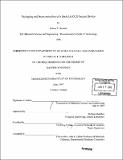| dc.contributor.advisor | William Robbins and Yet-Ming Chiang. | en_US |
| dc.contributor.author | Bennett, Joshua V. (Joshua Victor) | en_US |
| dc.contributor.other | Massachusetts Institute of Technology. Dept. of Materials Science and Engineering. | en_US |
| dc.date.accessioned | 2009-06-30T18:51:15Z | |
| dc.date.available | 2009-06-30T18:51:15Z | |
| dc.date.copyright | 1997 | en_US |
| dc.date.issued | 1997 | en_US |
| dc.identifier.uri | http://hdl.handle.net/1721.1/46285 | |
| dc.description | Thesis (M.S.)--Massachusetts Institute of Technology, Dept. of Materials Science and Engineering, 1997. | en_US |
| dc.description | Includes bibliographical references (leaf 48). | en_US |
| dc.description.abstract | This paper describes the engineering and development of a process to electrically and mechanically bond a large area, backlit charge-coupled device (CCD) sensor to a metallized substrate, using a materials system compatible with a high vacuum tube configuration. The CCD sensor is used in light sensor and digital camera devices. Currently, CCD devices are mechanically bonded to substrates using a variety of polymeric materials. For maximum resolution, however, the device must operate at high vacuum. Polymers release monomer molecules when exposed to a vacuum, since the polymerization reaction is far from equilibrium. Polymers also release retained solvent and binder molecules into a vacuum. This release of gas pollutes the high vacuum environment and degrades the tube perfomance. The CCD chip used in this research is extremely large, compared with standard semiconductor devices. The CCD chip measures 0.4 x 0.5 inches. At this size scale, thermal expansion mismatch stresses between die and carrier become an important design consideration, particularly for a die thinned to 10 micrometers. The proposed process results in a mechanical bond that is compatible with the high vacuum requirement, and is applicable to substrates of four possible materials: silicon, aluminum nitride, Pyrex, and LZS (a zirconia/ silicon nitride composite). The process also allows for two possible electrical connection techniques. | en_US |
| dc.description.statementofresponsibility | by Joshua V. Bennett. | en_US |
| dc.format.extent | 48 leaves | en_US |
| dc.language.iso | eng | en_US |
| dc.publisher | Massachusetts Institute of Technology | en_US |
| dc.rights | M.I.T. theses are protected by
copyright. They may be viewed from this source for any purpose, but
reproduction or distribution in any format is prohibited without written
permission. See provided URL for inquiries about permission. | en_US |
| dc.rights.uri | http://dspace.mit.edu/handle/1721.1/7582 | en_US |
| dc.subject | Materials Science and Engineering. | en_US |
| dc.title | Packaging and interconnection of a black-lit CCD sensor device | en_US |
| dc.title.alternative | Packaging and interconnection of a black-lit charged coupled device sensor device | en_US |
| dc.type | Thesis | en_US |
| dc.description.degree | M.S. | en_US |
| dc.contributor.department | Massachusetts Institute of Technology. Department of Materials Science and Engineering | |
| dc.identifier.oclc | 52925598 | en_US |
